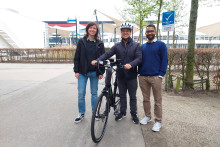The starting point is a room on the ground floor of the Citadel. There are two e-bikes waiting, albeit with a bit more bells and whistles than usual: two smartphones, a GoPro and a smiley feedback system are attached to the handlebars. While PhD candidates Mario Boot, Deepak Yeleshetty and Saxion researcher Annemarie Jutte are preparing all the systems, a heart rate monitor and a smartwatch are also being fitted. And a helmet. Science requires some sacrifice, but safety is one of the cornerstones of this research.
Smart Connected Bikes
This way, I am making a modest contribution to the Smart Connected Bikes project, a collaboration between the UT, Saxion, TU Delft, TNO and the Accell Group. 'What you see is that the speed, the crowds and the weight on bicycle lanes are increasing', Mario Boot outlines the context of the project. He conducts interdisciplinary research at the ET Department of Transport Engineering and Management and the EEMCS Department of Pervasive Systems. 'That leads to more accidents, while cycling actually provides numerous vitality benefits. The aim of this project is to make cycling safer and more enjoyable, so that more people are inclined to take the bike instead of the car.'
Today, this is done through a three-stage field test to which a ‘guinea pig’ is subjected: you complete the lap once without an active warning system, once a so-called bone conduction headset on, which beeps towards a 'zone with increased risk' designated on the basis of data. And once with gloves on, they vibrate when approaching such a zone.
The route leads from – ironically it would be – the particularly low-traffic O&O square via the Pinetum to the Twekkelerveld district. That at the end of the afternoon in this case – rush hour, with well-known obstacles along the way for many students. Just take the busy crossing of the Hengelosestraat, with convoys of cars in both directions. And who isn't familiar with the frustrating bicycle traffic jam that arises towards the centre of Enschede?
Advisory system
During the first exploratory tour of Twekkelerveld, there is no system that warns. How different is it after that first round – and filling in a short survey. It is now getting busier on the same route, but this time there is assistance in the form of the headset and the smartphone screen that lights up red when the first danger zone – the crossing of the Hengelosestraat – presents itself. The advice: reduce speed to less than 20 kilometres per hour. After complying to the nudge, the screen turns green.
There are more points along the way where the system warns, but where the test subject ignores that advice. Because why should I slow down, when I am convinced that that one corner is easy to make and I think a side street is clear? In the meantime, the headset and helmet are a bit uncomfortable and I get distracted by the multiple screens and the feedback system... Now your reporter on duty is a cyclist of the impatient and stubborn kind. The kind of one that brakes late, cuts corners, thinks he needs a small gap to pass and at times sees the right of way as a privilege, not a rule.
Vibrating gloves
In the third round, the headset is exchanged for gloves that give vibration signals. It is now heading towards 5 p.m. and even more traffic on the road. But in personal experience, this system is a bit less invasive. Perhaps also because I can now dream the tour of Twekkelerveld (hello Toons Snelbuffet) and have adjusted to the advices of the system a bit more. Moreover, it is difficult to cycle faster than 20 per hour in the Hengelosestraat bicycle traffic jam. The conclusion, however, is that the well-meaning warning system and the stubborn test subject will never become best friends. He still believes that one's own senses are sufficient to assess the necessary dangers. Whether that is wise, the future will perhaps one day show in a painful way.
A final short survey follows and the field test is over. In the coming weeks, the researchers hope to welcome dozens more participants. In the months that follow, it is up to the scientists themselves to process the buckets of data, analyse them and write papers. It is therefore still far too early to draw conclusions, although the test subject on duty has already drawn them for himself: preferably as few fellow road users as possible and as few bells, whistles, sensors and screens as possible. Moreover, an oncoming cyclist biking the wrong way was anecdotal proof that dangers do not necessarily always reside in certain zones, but can also arise from bewilderment.
Gadgets
Still, the UT researchers' findings could pave the way to safer cycling. ‘Compare it to all the gadgets that cars have – parking sensors, cruise control, collision detection... To make cycling safer and more attractive, it is interesting to explore what is possible for cyclists,' says Boot. 'And not through gloves, for example, but through vibrations in the handles, if the gloves are not comfortable,' Jutte adds. 'It is important that intelligent mobility technology works increasingly better with cyclists and other road users.'
A similar field test took place in Amsterdam, says Boot. 'The big difference in Amsterdam was that the focus in Amsterdam was on physically limiting speeds in high-risk zones. We want to give the cyclist a little more freedom. They have to make the decisions, while the system warns via nudging.'
Yet, at one point, it would not have been a bad idea to intervene strictly with the reporter/test subject. During the second lap, he slalomed around an elderly person crossing the street, while a car wanted to turn right at that moment. A corrective electric shock would not have been undeserved.







